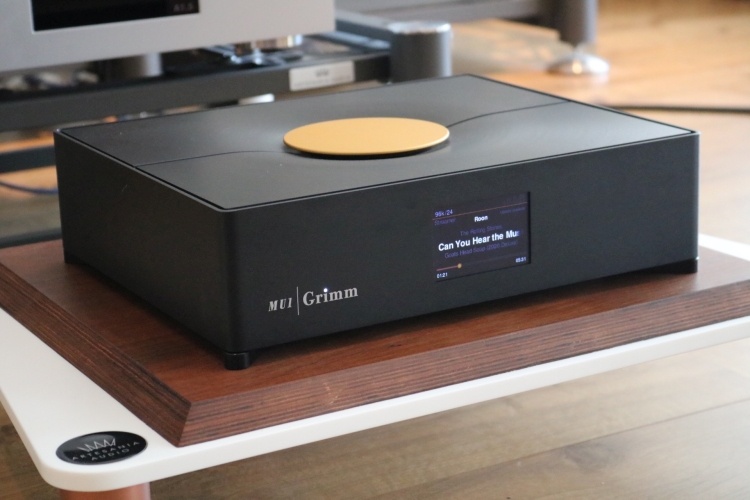
Review Context
The MU1 will be listened to in combination with the CH Precision C1 DAC that connects via a CH Balanced Link XLR cable directly to the CH Precision A1.5 power amplifier that, in turn, drives Magico S1 Mk2 loudspeakers via Jorma Trinity speaker cables. I will use the Antipodes K50 Music Server, the Aqua LinQ with UPnP and HQPlayer NAA player boards, and various CD transports as comparative sources.
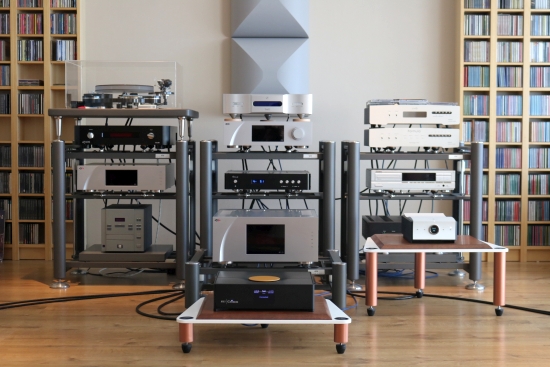
All power cables are Belden with Bals Schuko and Oyaide C-004 IEC connectors, interlinks are CH Precision Balanced Link and speaker cables are Jorma Trinity.
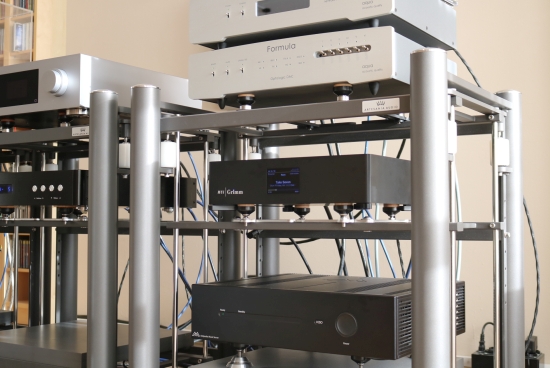
Listening
According to Grimm Audio, Roon offers the best High-End user experience to date, and when it comes to the comfort of the user interface, I can only agree. In terms of sound, however, I have repeatedly found that Roon differs from alternatives such as UPnP/DLNA, Squeezelite, HQPlayer, and MPD. In short, these aforementioned formats tend to sound tighter and more incisive than Roon (and arguably drier) while the latter tends to sound fuller and richer (and arguably less immediate and exciting).
Roon had always sounded fuller to me than most other streaming- or music playback methods, but it was with the Aqua LinQ network interface that I noticed these differences very clearly. And thereafter, I confirmed the relative differences with every other piece of hardware that I used. With this in mind, and given that I like my system to be as articulate as it can be, I was reticent to jump on board the MU1 experience. But little did I suspect that the MU1 was about to turn these experiences on their head!
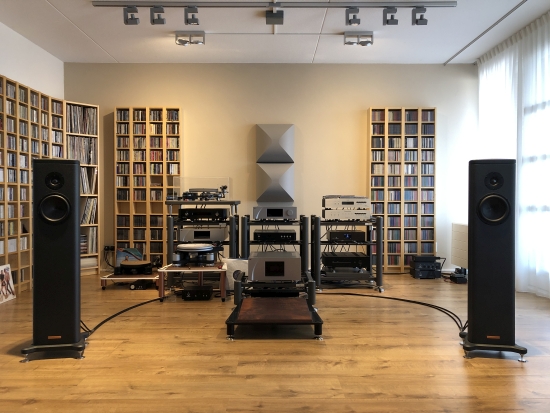
I started listening with the MU1’s 4x Oversampling engaged, as recommended. Later, I will also try the other modes.
From the very first notes coming from the MU1, connected to the C1 DAC via a Jorma AES/EBU cable, it was clear that the Grimm unit was superbly articulate and exhibiting none of the smoothing and rounding effects that I have gotten used to when using Roon in combination with other devices. Actually, without any comparisons, I’d already say that the MU1’s bass was really close to being as superbly incisive and defined as that of the Aqua LinQ. All I needed was half a song to know that it wasn’t just the bass – there was something fundamentally very right about the MU1’s overall performance.
Being a bass fetishist, I wanted to settle the bass aspect first. In parallel with the MU1, I connected the LinQ to the C1 with the MU1 using another Jorma AES/EBU cable and selected the UPnP input. This leads to the tightest, fastest, and most articulate delivery that I have so far been able to produce with the available equipment. Then, I compared it to the MU1 using a copy of the exact same recording and starting it simultaneously and then switching between the two devices. Well, I’ll be… this is an absolute first. Never before has a Roon source come even remotely close to sounding as a UPnP source, and certainly not in the bass. But after careful comparison, I can absolutely confirm that the MU1’s bass is every bit as incisive, articulate, fast, authoritative, and punchy as that of the LinQ.
But it’s not just in the bass where the Grimm surprised me. Along with this superlative bass performance, comes a richer tonal saturation and a more organic fleshing out of projected images that lends more body and substance to vocals and instruments, adding realism and raising the emotional involvement. The LinQ remains beautifully neutral and in many facets, it is a match for the MU1 but in comparison, it now sounds tonally and dimensionally a little flatter and overall more matter of fact. What also makes the MU1 special is that it has more air and fluidity in the upper treble which further aids the emotional aspect.
What’s more, its precision and transparency notwithstanding, the MU1 has a captivating sense of flow that I have thus far only heard from Antipodes servers. Granted, the K50, using its own AES/EBU output sounds still smoother, fuller, and warmer, and with its supremely lush sound that washes over you completely unforced, it could be regarded as even more organic than the MU1. But the MU1 does dig considerably deeper in terms of articulation, low-level resolution, and ultimate finesse. With its higher precision, the MU1 is consistently more convincing while 100% avoiding sounding computer-esque or over-controlled.
In terms of spaciousness, the K50 and the MU1 have similarities and differences. They both are just as capable of a room-filling sound in all directions but the difference is in the precision of imaging within the soundstage. Whereas the K50 unveils the layering as captured in recordings with no problems, the MU1 manages to portray them with more precision. It’s almost as if the software found a hidden focus dial that was somehow left in the middle position and now turned it all the way up.
Adding the LinQ to the mix using HQPlayer on the K50 with Roon, the combination gains articulation and tightness compared to the K50 used on its own but it also loses a portion of the server’s organic and lush quality in the process. And, remarkably, the MU1 still beats the combo in terms of speed, articulation, and precision. How I love the MU1’s way with transients – they’re lightning fast! But never ever are they over-etched and there’s never a feeling of hardness or sharpness. There’s nothing that stands in the way of the musical performance. Rather, everything is balanced just so that the audiophile mind agrees while the soul latches on.
Sonically, the MU1 leaves nothing to be desired. Functionally, it offers fewer options in terms of streaming- and playback methods than the K50 and also has fewer output options. Whereas the Antipodes is something of a Swiss Army Knife by offering a multitude of server- and streamer software options that output as AES/EBU, S/PDIF on coax, S/PDIF on BNC, I2S, and USB, the MU1 is currently limited to Roon only and offers only AES/EBU outputs. But whether or not this matters will depend on the intended use. And especially since Roon has been implemented such that it sounds in line with the best formats, why should one want to go beyond Roon?
I certainly would not have expected it after raving about the K50 relatively recently, but the MU1 has impressed me deeply. It may not offer all of the big Antipodes server’s functionality, but sonically, it takes what the K50 does, which is to sound like music, not clinical computer replay, while further adding to it to provide the best I’ve heard yet from a Music Server!
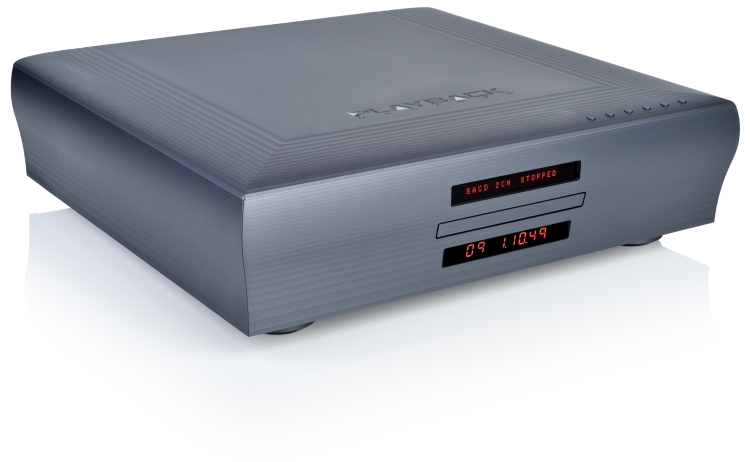







Hi Christiaan,
interesting review! Especially the comparison with the Aqua LinQ, which I own as well. Knowing the LinQ really well, it would be interesting to read how it compares with the latest and best implementation of the NAA + CORE module, allowing it to the the embedded HQPlayer on its own. If you have the chance, definitely ask for this upgrade – in my ears that’s a different level.
Best Robert
Hi Robert, as we speak, I am reviewing the Core+NAA module. And indeed, it is a very noticeable step up!
Hi Christiaan,
nice! Looking forward to your impressions. In my system, the
LinQ is connected via I2S to the La Scala MKII Optologic DAC – my perfect match with a sound signature more on the emotional/warmer side.
Best Robert
Hello Christiaan, thanks for another excellent review.
Any change of you reviewen the streamers from Hifi Rose?
regards Albert van Bentem
Hi Albert, I have no plans for that, but I will add the brand to the list of items that might deserve a review.
Hi Christian,
It was your review that takes away the last hordes and decide me to buy the Antipodes K50.
All my flacs on the internal SSD’s and only the ethernet connection for Roon updates and remote control. I use Squeezelite as player. The differences you describe with the K50 versus MU1 is what I do hear with the AES/EBU versus the I2S (HDMI) outputs.
I do use the fantastic Denafrips Terminator Plus which can do up/over sampling but I prefer the “rawer” NOS mode.
And there is something I do not like with this Grimm MU1; Updates (hard- and software) that can’t be implemented on the older units. The people that did buy these new and unknown server, paved the path for the upcoming innovations and should be “rewarded” for buying the first units.
Hello Christian,
I am in the market for a new Roon core server and have read your excellent reviews with interest. I currently use a SGC I7. But I have just auditioned a K50 for about a month.
I have ordered a Tambaqui Dac to replace my Bricasti and wondered if the Grimm might be a better match. However, I use convolution filters in Roon DSP and wonder if the I3 in the Grimm is underpowered?
Hi Jeff, the Tambaqui sure is a nice DAC, so long as it is used with an analog preamp. The MU1 and the K50 are both great but they have very different sonic presentations and which one is the better match will be a matter of personal preference and perhaps system synergy. FWIW, the MU1 in its current incarnation sounds clean, fast and very transparent and I would describe the Tambaqui similarly, albeit with a touch of gentle smoothness. The K50, on the other hand, has a full, smooth, and relaxed sound. Do you want to maximize transparency, articulation, resolution, and neutrality? Then the Grimm might be ideal. Do you want to pull the sound more toward fullnes, deeper tonal saturation, and liquidity, then the K50 could be more ideal. Regarding the processing power, I’m afraid I can’t provide a definitive answer as I do not currently use convolution filters. However, I have used these in the distant past with a much older and simpler machine and do not recall any slowing down or snappiness with the UI or the music playback.
Hi Christiaan, what is your impression of the latest Roon (2.0)/ firmware (1.5) updates?
Hi Vincent, Roon SQ is always going up and down, or sideways, depending on your view. And as it turns out, the MU1 is also sensitive to these changes in Roon SQ. For me, 2.0 sounds smoother and more polite than 1.8 (which some will like) but also less forceful and incisive (which I do not like). But I have been hearing small improvements with the latest crop of Roon updates. It’s not back to how 1.8 was at its peak, but it’s better than it was with the first incarnation of 2.0.
For me, the latest Grimm update (1.5) has barely had an impact on the sound quality from the last version (1.4). I thought I did hear ever so slightly duller treble but it’s important to note that the simple act of restarting can also subtly affect the sound, at least for a short period of time. In my successive day-to-day listening, the MU feels the same as it did with 1.4. If there really is a delta then it’s too small to reliably detect or describe. I was also happy to find that switching on/off the second output seems to be transparent.
For me, the last Roon update was a good one: detail retrieval got beter, and separation of instruments improved. There is no way to travel in history and go back to 1.8 I guess..
Thanks for sharing your impressions!
Hi Christiaan
Hope you are doing well. Love your site, reviews, methodology and style.
Have you had the chance to hear the Rockna wavedream net server, and if so how would it compare to the Grimm MU1 ?
Cheers
David
Alas, I have not heard any Rockna equipment yet.
Hi Christiaan, though this is not the right thread for my question: but why did you never put the Taiko Extreme to the test? And what about the newly introduced Audiophool Music Server 2.1?
Hi Vincent, I work for Taiko Audio. As such, there would be a conflict of interest:-) I have not heard the AudioPhool nor have I been approached by them.
I see, thats a really shame since I had them both in and compared last week. I was really curious about your findings. Since the TE is considered to be the ultimate reference streamer, it makes other comparisons somehow less relevant. But I get your point regarding CoI.
My main takeaway: the Taiko Extreme SGM has crazy resolution and black background combined with larger than life soundstage. The first guitar plucks in Private Investigations – Dire Straits sounded like real metal strings where the MU1 like plastics. Though better in nearly every aspect, the MU1 on the other hand offers a more relaxed presentation and more forgiving with less ‘audiophile’ mastered tracks. For example Michael Jackson – Thriller was a better performance on the MU1.
The TE performance reminded me of the moment using a TDK SA-X cassette tape for the first time on My first Sony walkman 🙂
Hi Christiaan,
I love your reviews and think that you write the best reviews for digital gear.
I was ready to buy MU1 but am backing off after the May 5, 2024 update. I thought that Grimm eliminated all other influences on SQ by their processing and reclocking of outputs. It does not seem to be happening based on your May update.
Are you using Roon only for the music library management and to pass unmodified data to the Grimm board, that is, without any processing or over sampling by Roon?
Any comments are welcome.
Regards,
Tony
Hi Tony, thanks for the nice feedback. It’s a tricky field. Purely theoretically, certain deviations are accounted for in margings, but large deviations should not occur. However, as I find with any gear, even digital gear, there are always influences, and circumstances matter. Depending on who you ask, my observations are spot-on, exaggerated, or not even possible. I have two friends with MU1s and one of them agrees with my findings while the other does not notice any differences. At the end of the day, all I can do is relay what I hear. But importantly, even though it changed since I first reviewed it, the MU1 is still my favorite Roon server.
Roon’s DSP functionality is superb and can come in handy when your room is not ideal and remodeling or treatment is out of the question. Using Roon DSP, I made my then non-SAM Genelec speakers sound really good even though they were in a narrow kitchen area. For my main system, however, I prefer not to use DSP or any Roon plugins, as they have an audible impact. Then again, if the room has severe issues, the net result with DSP can still be much better than without it.
When using the MU1 with its AES/EBU output, I have the Grimm’s oversampling set to none. But currently, the MU1 sounds best to me when streaming to the CH Precision’s C1.2 RoonReady Ethernet input. Even in this capacity, the MU1 has a large advantage over running Roon Core on a standard PC.